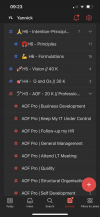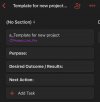I want to say I'm new to GTD (around a year), but I'm finally using office 365 to manage everything for my life and seems they are working well. Just watched the video about the omnifocus, it has some features, but I would not use it as I have to use many other tools to do support and reference.
However, in office365, with OneNote, Onedrive (and a little MS ToDo, I used it to implement GTD, but found out I juse need onenote, that's enough. ). I can execute all GTD very well and Onenote is a super reference/support docs. Actually one notebook is sufficient (but for different working environments, I have to use multiple notebooks for reference/support).
I'm really interested to connect with any people who are using office365 for GTD. Please connect and share. Thanks!
As a clinical social worker, with a case load, I have extremely focused moments of opportunity for therapeutic engagement. That means I have to be on my game with everything in flow in the moment when the door is open.
At work, we have the full suite of Microsoft 365, and I've been using Microsoft ToDo for Next Action Support. OneNote for Project Support.
I use the standard GTD contexts, with a couple focused lists - based on Areas of Focus by context.
One trick I use is to consistently include the initial of each client I have. That way, while standing in front of them, I can do a search for their initials, and find each entry, across all contexts. For example, if I was looking for myself -- PG* I put the asterisk afterwards, to resolve any initials that maybe part of a word. I'm noticing this works better in the portal, and good enough on the iPhone.
Primary data input is via the web-portal of ToDo. The game-changer is the seamless synch to iPhone, which I'm primarily using in the field.
Key: Minimal contexts. When I find, over time, that the entries are zero - I delete the context. When there are too many entries, it's likely because they're not really in an actionable context.
Therapeutic engagement - this works because what comes over consistently to the client is that it's evident I really care about keeping track of every single next action, across every single project we're working on. Nothing is overlooked or lost. Something tangible occurs when the client knows I care, to that level of detail.
Also... I don't have to remember endless items!
Welcome to the world of GTD. I've been integrating this since 2006. The idea is to be continually flexible (experimenting with different approaches) to ensure you're efficiently externalizing your mind.






